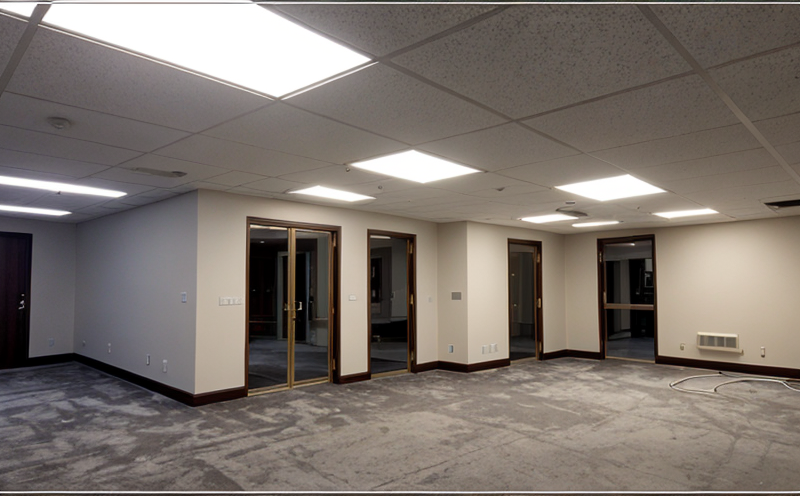EN 12464 1 Indoor Decorative Lighting Testing of Workspaces
The European Standard EN 12464-1 defines the requirements and testing methods for indoor decorative lighting in workspaces. This standard ensures that the lighting used in interior environments meets specific safety, performance, and ergonomic criteria to enhance visual comfort and reduce eye strain.
EN 12464-1 is particularly important for architects, designers, and manufacturers of architectural and decorative lighting fixtures. Compliance with this standard helps ensure that the products are safe for use and meet the necessary quality standards set by regulatory bodies in Europe.
The testing process under EN 12464-1 involves several key steps:
- Light Output: The luminance, color temperature, and light distribution of the lighting fixture are measured to ensure they meet specified values for visual comfort and energy efficiency.
- Color Rendering Index (CRI): This parameter assesses how accurately colors are rendered under different types of lighting. High CRI ensures that objects appear natural and vibrant in the workspace.
- Glare Control: The standard includes tests for glare, ensuring that reflections do not cause discomfort or reduce visibility.
- Cut-off Angle: This parameter measures the angle at which light is directed away from direct view to minimize light pollution and improve visual conditions indoors.
- Electrical Safety: The standard also covers electrical safety, ensuring that the lighting fixtures are free from hazards such as overheating or short circuits.
The testing process typically involves:
- Specimen Preparation: Lighting fixtures are prepared according to the specific requirements of EN 12464-1. This includes ensuring that all components are intact and ready for testing.
- Instrumentation: High-quality measuring instruments such as colorimeters, photometers, and spectroradiometers are used to capture precise data on light output, color rendering, and other parameters.
- Data Collection and Analysis: Data is collected during the tests and analyzed to determine compliance with the standard. Any non-compliance findings are documented for corrective action.
The results of the testing process provide valuable insights into the performance of the lighting fixtures, ensuring that they meet the necessary standards for visual comfort and safety in workspaces. Compliance with EN 12464-1 is crucial for manufacturers to ensure their products meet regulatory requirements and gain market acceptance.
Industry Applications
- Interior Design Studios: Lighting designers use this standard to create visually comfortable environments that enhance creativity and productivity in design studios.
- Office Spaces: Manufacturers of office lighting fixtures use EN 12464-1 to ensure their products meet the ergonomic requirements for visual comfort and energy efficiency in modern offices.
- Hospital Rooms: Healthcare facilities employ this standard to ensure that the lighting in patient rooms is safe, comfortable, and conducive to healing.
- Retail Stores: Lighting in retail spaces must be bright enough to display products clearly while being gentle on the eyes. EN 12464-1 helps manufacturers meet these requirements.
- Dining Areas: Restaurants and cafes use this standard to create an inviting atmosphere that enhances the dining experience, ensuring both visual comfort and energy efficiency.
- Education Facilities: Schools and universities use EN 12464-1 to ensure that lighting in classrooms promotes learning by providing a comfortable and safe environment for students.
- Residential Spaces: Homeowners and interior decorators rely on this standard to create aesthetically pleasing and ergonomically sound living spaces, enhancing the quality of life.
The application of EN 12464-1 across various industries underscores its importance in ensuring that lighting fixtures meet both regulatory requirements and user expectations for visual comfort and safety.
Eurolab Advantages
EuroLab stands out as a leading provider of lighting testing services, leveraging cutting-edge technology to deliver accurate and reliable results. Our team of experts ensures that all tests are conducted in compliance with the latest international standards, including EN 12464-1.
- Accurate Testing: Using state-of-the-art instruments, our laboratory can provide precise measurements of light output, color rendering index, and other critical parameters.
- Compliance Assurance: Our team ensures that all testing processes adhere to the requirements set forth in EN 12464-1, providing you with confidence that your products meet regulatory standards.
- Rapid Turnaround Times: EuroLab prioritizes customer satisfaction by offering quick turnaround times for test results, allowing you to bring your products to market faster.
- Comprehensive Reporting: Our detailed reports include all relevant data and recommendations for improvement, ensuring that you have a clear understanding of the performance of your lighting fixtures.
- Expert Consultants: Our team of experts provides valuable insights and advice on how to optimize the design and performance of your lighting fixtures.
- Cost-Effective Solutions: EuroLab offers competitive pricing and flexible testing packages, ensuring that you receive high-quality services without breaking the bank.
EuroLab's commitment to excellence in lighting testing makes us the preferred choice for quality managers, compliance officers, R&D engineers, and procurement professionals across various industries.
Environmental and Sustainability Contributions
The testing of indoor decorative lighting under EN 12464-1 plays a crucial role in promoting environmental sustainability. By ensuring that lighting fixtures meet the necessary standards for visual comfort and energy efficiency, this process helps reduce waste and minimize the environmental impact of lighting products.
- Energy Efficiency: High-efficiency lighting fixtures consume less electricity, reducing carbon emissions and lowering utility costs.
- Material Waste Reduction: By ensuring that lighting fixtures are durable and long-lasting, the testing process helps reduce waste in landfills.
- Resource Conservation: Energy-efficient lighting can help conserve natural resources by reducing the demand for electricity generated from non-renewable sources.
- User Health and Well-being: Properly designed lighting enhances visual comfort and reduces eye strain, contributing to overall user health and well-being.
The testing process under EN 12464-1 is an essential step in the journey towards creating a more sustainable built environment. By ensuring that lighting fixtures meet the necessary standards, EuroLab plays a vital role in promoting environmental sustainability.





